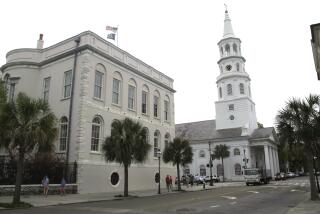Charleston: A City of Historical Firsts
CHARLESTON, S.C. — The world’s first successful submarine attack occurred in Charleston Harbor, Feb. 17, 1864, when sailors aboard the 25-foot-long Confederate sub, the H. L. Hunley, sank the Union warship Housatonic.
Powered by eight men hand-cranking its propeller, the Hunley was a primitive ship. It had a maximum speed of 4 m.p.h. Its torpedo filled with 90 pounds of gun powder was towed and pulled against the hull of the target ship.
When the Housatonic’s magazine was blown up by the torpedo, five Union sailors were killed. The rest were rescued. But the Hunley had worse luck. It was sunk by the explosion aboard the Housatonic, and the sub’s entire crew perished.
Now a replica of America’s first submarine to sink an enemy ship stands outside the Charleston Museum, America’s first museum that was built in 1773.
The beginning of submarine warfare and the nation’s original museum are just two of the many firsts that happened in historic Charleston. Founded in 1670, it’s truly a city of firsts.
This is the home of America’s first woman artist, Henrietta Johnson, who painted portraits of Charleston’s leading men and women beginning in 1707. The South’s first newspaper, the South Carolina Gazette, was edited and published from 1739-44 by Elizabeth Timothy, America’s first woman editor and publisher.
America’s first theater, the Dock Street Theater, opened in 1736 with the play “The Recruiting Officer.” Later that same year, the first opera in America was performed there.
In 1800, Planter’s Hotel was erected on the site of America’s first theater whose fate was lost in obscurity. It was here Planter’s Punch originated. The hotel thrived for nearly a century, then fell into ruin until Harry Hopkins, President Franklin Roosevelt’s secretary of commerce, reconstructed the Dock Street Theatre in 1936.
“The Recruiting Officer” reopened the theater just as the play had launched it 200 years earlier. Footlight Players, the city’s oldest community theater group, operates and manages the city-owned theater.
Charleston was the home of the Friendly Society for the Mutual Ensuring of Houses Against Fire, America’s first fire insurance company. The company didn’t last long. It went belly-up when the great fire of 1740 destroyed more than 300 buildings.
America’s first Chamber of Commerce was organized in Charleston in 1773. That was the year the Charleston Library Society founded America’s first museum. Four signers of the Declaration of Independence were among the Museum’s earliest directors.
An 1826 Charleston Museum poster proclaims: “An extensive collection of beasts, birds, reptiles, fishes and many curiosities among which are the head of a New Zealand chief, an Egyptian mummy and a great white bear from Greenland. Occasional performances by a band of musicians. Admittance 25 cents.”
During the Civil War, the museum’s collections were removed from Charleston to a plantation where they were buried to protect them from Union forces. Present director of America’s oldest museum is John Brumgardt, 43, a native Southern Californian who received his Ph.D. in history from UC Riverside and was director of the Riverside County Museum in the 1970s. “It is a great honor to be director of America’s first and oldest museum,” Brumgardt said.
The College of Charleston, the first municipal college in America, and the oldest publicly supported college in the U.S., opened its doors in 1770. The college boasts three signers of the U.S. Constitution and two signers of the Declaration of Independence among its founding fathers.
In the time-honored graduation ceremonies at the College of Charleston, women wear long colonial gowns and men wear tuxedos.
It was here in Charleston that the first decisive American victory of the Revolutionary War took place--a rout of British forces trying to invade Charleston. And the first shots of the Civil War were fired at Fort Sumter.
America’s first passenger railroad train called the “Best Friend” started service from Charleston to Hamburg, S.C., in 1830 along 136 miles of track. It was the longest continuous railroad in the world at the time.
Charleston is America’s “Porgy and Bess” town. The former tenements on Cabbage Row were the model for DuBose Heyward’s Catfish Row in his novel entitled “Porgy,” which was turned into the popular folk opera “Porgy and Bess.” It was called Cabbage Row because its black residents sold the vegetable out of their window sills.
Charleston, the city that gave the most popular dancing style of the 1920s its name, is one of America’s best preserved cities.
That, too, is because of a first.
On Oct. 13, 1931, the Charleston City Council established the Charleston Old and Historic District, the nation’s first historic zoning ordinance to preserve a city’s architectural heritage.
Today, there are more than 2,000 restored old buildings, many having tiered porches called piazzas lining narrow brick alleys, cobblestone streets and walled courtyard gardens. These architectural treasures dating from the 1600s to the Civil War have been preserved and restored under the leadership of the Preservation Society of Charleston.
And, it is also said that Charleston, city of firsts, never lets progress stand in the way of historical restoration.
More to Read
Sign up for Essential California
The most important California stories and recommendations in your inbox every morning.
You may occasionally receive promotional content from the Los Angeles Times.










